Cyber threats are continuously evolving, with attackers adopting new techniques and exploiting vulnerabilities across various platforms. Recent reports highlight a string of high-profile attacks and underline the necessity for robust cybersecurity measures. The rise of collaborative threat groups, sophisticated ransomware operations, and vulnerabilities in both software and hardware emphasize the critical need for proactive and comprehensive security strategies.
Collaborative Threat Groups
Recent findings from Kaspersky reveal a strategic alliance between two threat activity clusters, Head Mare and Twelve. This collaboration is aimed at amplifying attacks on Russian entities, combining resources from both groups for greater impact. This partnership marks a significant increase in the sophistication and scale of their operations, with Head Mare noted for exploiting a WinRAR vulnerability (CVE-2023-38831) to deploy malware and ransomware like LockBit and Babuk.
Twelve, conversely, engages in destructive attacks, using publicly available tools to encrypt victim data and making substantial use of tools associated with Head Mare. Such alliances indicate a methodical approach to expanding their attack vectors, enhancing the effectiveness and reach of their operations. This coordination between distinct threat groups underscores the escalating complexity of cyber conflicts, necessitating advanced threat intelligence and collaborative defense mechanisms among cybersecurity professionals globally.
Cloud-Native Ransomware Attacks
The SANS Institute has alerted to emerging trends in cloud-native ransomware attacks, exploiting highly sensitive data in cloud storage buckets. Alarmingly, 66% of these buckets contain valuable data, presenting a goldmine for attackers. Palo Alto Networks reports how legitimate cloud security features, like Amazon S3’s SSE-C encryption and AWS KMS keys, are being abused for ransomware operations. Attackers leverage these features to perform unauthorized encryption, effectively hijacking normal security functionalities for malicious purposes.
These findings highlight the urgent need for securing cloud environments against internal abuse. Organizations must adopt meticulous configuration and monitoring practices to safeguard against such exploits. The dynamic and adaptable nature of ransomware requires comprehensive security measures, including rigorous access controls, constant vigilance, and proactive threat detection. Protecting cloud infrastructure from the exploitation of its own security features is crucial in mounting an effective defense against these sophisticated attacks.
Software Supply Chain Vulnerabilities
A critical supply chain compromise in GitHub Action, tj-actions/changed-files, has resulted in a high-severity vulnerability (CVE-2025-30066). This flaw allows attackers to inject malicious code and access sensitive data from actions logs, such as AWS access keys, GitHub tokens, npm tokens, and RSA keys. The inclusion of this vulnerability in CISA’s Known Exploited Vulnerabilities catalog emphasizes the importance of vigilance within software supply chains. Ensuring protection against such attacks is paramount for maintaining security integrity.
Supply chain attacks pose a significant risk as they provide a gateway for malicious actors to infiltrate numerous systems through a singular point of vulnerability. This heightened threat level calls for stringent security protocols, including regular code audits, dependency management, and continuous vulnerability assessments. The complexity of modern software, combined with the interconnected nature of development environments, necessitates a robust and multilayered approach to security to thwart potential compromised supply chains.
Unpatched Windows Zero-Day Flaw
An unpatched Windows zero-day (ZDI-CAN-25373) continues to be exploited by state-sponsored groups since eight years ago. This flaw allows execution of hidden commands via crafted Windows Shortcut files, presenting an ongoing threat from nations like China, Iran, and North Korea. The longevity and persistence of this vulnerability highlight the pressing need for timely patches and security updates. State-sponsored exploitation of this flaw underscores the geopolitical dimension of cyber espionage and data theft.
This zero-day vulnerability presents a clear and present danger to systems worldwide, as various state actors leverage it for espionage and data theft. Consistent exploitation over many years demonstrates the necessity for regular patch cycles and active vulnerability management. Organizations must prioritize updates and security measures to counteract these risks, acknowledging that even longstanding vulnerabilities can pose significant threats if left unaddressed.
Hardware-Level Vulnerabilities
AMI’s MegaRAC Baseboard Management Controller (BMC) software faces a critical vulnerability, CVE-2024-54085, which enables remote attackers to bypass authentication and potentially damage server hardware. This flaw poses a severe threat to data center infrastructures, with its CVSS score of 10.0 indicating maximum severity. Effective measures to secure these hardware components against such attacks should be a high priority for all organizations relying on server infrastructure.
Hardware-level vulnerabilities, such as the ones affecting BMC software, can have catastrophic impacts on data centers and critical environments. These flaws allow attackers to manipulate the fundamental operations of servers, potentially leading to malware deployments, firmware tampering, and physical damage to server hardware. Addressing these vulnerabilities requires collaborative efforts from hardware manufacturers, cybersecurity experts, and IT administrators to ensure robust protections and timely fixes.
SAML Authentication Risks
GitHub has uncovered vulnerabilities in the ruby-saml library (CVE-2025-25291 and CVE-2025-25292), compromising SAML authentication protections. These inconsistencies in XML parsing between REXML and Nokogiri parsers open the gates to account takeovers and unauthorized access. Addressing these vulnerabilities is vital for protecting authentication mechanisms and maintaining trust within digital platforms. Continuous monitoring and patching of authentication libraries are essential strategies in mitigating these risks.
SAML authentication protocols are foundational for secure access control across numerous applications and services. Vulnerabilities within these systems pose significant security risks, enabling attackers to execute signature wrapping attacks that can lead to unauthorized access. Maintaining the integrity of authentication procedures demands constant vigilance, routine updates, and comprehensive security practices to actively defend against these threats. Continuous improvement in authentication standards is crucial to safeguard user accounts and sensitive data.
Dynamic Nature of Cyber Threats
The recurring theme of evolving cyber threats highlights the dynamic nature of the landscape. Attackers are constantly adapting tactics, exploiting both new and old vulnerabilities, and targeting various platforms. This trend necessitates a comprehensive approach to cybersecurity, combining timely vulnerability management, stringent access controls, and proactive monitoring. The collaboration between threat groups like Head Mare and Twelve further illustrates the increasing sophistication of attacks.
The ever-changing landscape of cyber threats calls for an adaptive and responsive defense strategy, emphasizing the need for continuous security vigilance. Organizations must equip themselves with advanced threat detection tools, establish robust access control mechanisms, and practice proactive monitoring to stay ahead of adversaries. As attackers refine their techniques and form alliances, such as those seen with Head Mare and Twelve, the cybersecurity community’s collective response must be equally sophisticated and unified.
Imperative for Comprehensive Security Strategies
To combat evolving threats effectively, organizations must adopt holistic security strategies. This includes integrating advanced threat detection, regular patch management, and robust incident response capabilities. Fostering a culture of continuous security awareness and collaboration among stakeholders is crucial for maintaining a secure digital environment. The cybersecurity community must remain vigilant and proactive to safeguard digital assets against increasingly sophisticated threats.
A comprehensive security approach involves not only technical measures but also cultivating a security-conscious culture within organizations. Regular training, awareness programs, and collaborative efforts between various departments are essential to fortify defenses against cyber threats. Advanced threat detection systems, routine vulnerability assessments, and a proactive incident response framework are pivotal components in establishing resilient cybersecurity. By combining these elements, organizations can build a robust defense capable of adapting to the ever-evolving cyber threat landscape.
Proactive Measures and Future Considerations
Cyber threats are constantly evolving, as attackers continuously develop new techniques and increase their exploitation of vulnerabilities in various platforms. Recent reports have showcased numerous high-profile attacks, stressing the urgent need for robust cybersecurity measures. The surge in collaborative threat groups, advanced ransomware operations, and vulnerabilities in both software and hardware make it clear that proactive and comprehensive security strategies are crucial. As these threat actors grow more sophisticated, they are capable of executing targeted attacks with significant consequences. Combining advanced technology with increased awareness and training, organizations must adopt a multi-layered approach to effectively combat these persistent threats. Further, the importance of regular updates and patch management cannot be overstated, since even minor lapses can provide opportunities for attackers. In today’s digital age, thorough cybersecurity efforts are not just a recommendation but a necessity, ensuring that systems and data remain safeguarded against an ever-evolving landscape of cyber threats.








